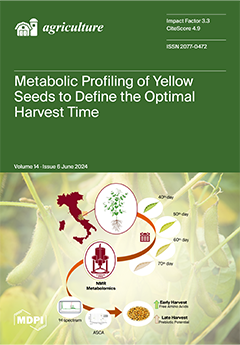Forage maize is one of the most important feed crops for livestock production, and is mainly grown in northwest China. However, their growth is often stressed by limited soil water availability due to the arid climate. To provide more soil moisture, a high-efficiency
[...] Read more.
Forage maize is one of the most important feed crops for livestock production, and is mainly grown in northwest China. However, their growth is often stressed by limited soil water availability due to the arid climate. To provide more soil moisture, a high-efficiency tillage technique was required to make crops effectively use soil moisture in deep soil layers. Deep vertical rotary tillage is a promising choice for this purpose. In this study, a long-term (2020–2022) field experiment consisting of three treatments, i.e., traditional tillage (TT), deep rotary tillage (DT), and deep vertical rotary tillage (VRT), was carried out in semiarid areas of Loess Plateau, northwest China, to investigate the effects of VRT on soil water storage (SWS), phase crop evapotranspiration (ET
c) during the pre- and post-flowering periods, dry matter accumulation, grain yields and the water use efficiency (WUE) of forage maize. The results showed that VRT significantly improved the absorption of soil moisture from deep layers, especially in dry years. During the pre-flowering period of a dry year (2020), VRT decreased SWS by 7.6%–10.0% in the 60–180 cm layer, and by 17.6%–18.5% in the 180–300 cm layer, respectively, compared to DT and TT. As a result, VRT increased ET
c during the pre-flowering period by 6.1% and 9.2%, respectively. In wet years (2021 and 2022), VRT increased total ET
c by 2.0%–7.9% in 2021, and by 10.1%–14.9% in 2022, respectively. On average, VRT increased the dry matter weight per plant by 1.0%–7.8%, grain yields by 2.4%–38.6%, biomass yields by 3.4%–16.2%, and WUE by 10.1%–30.0%, respectively. Particularly, the benefit of VRT for increasing yields and WUE was more noticeable in dry years. It can be concluded that VRT is a drought-tolerant and yield-boosting tillage technique that is suitable for rain-fed forage maize in semiarid areas of Loess Plateau, northwest China.
Full article





